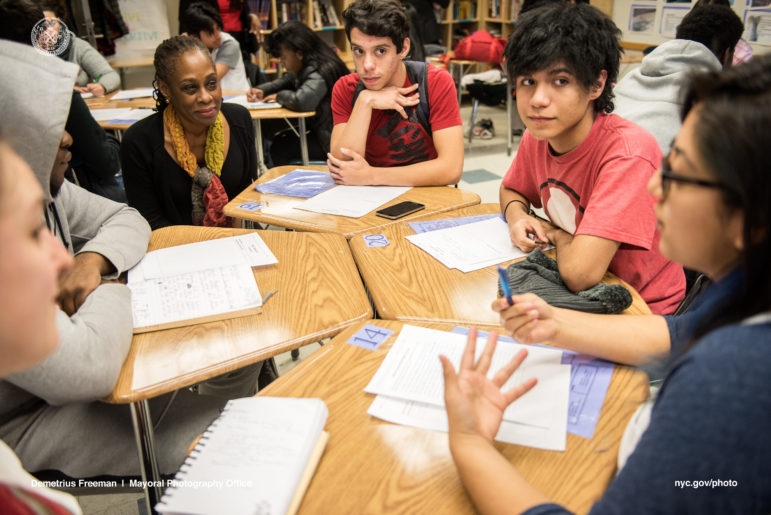‘While students face different kinds of obstacles in their previous schools, from mental health to family obligations or just a lack of support, they found trusting relationships and a new sense of purpose at their transfer schools.’

Demetrius Freeman/Mayoral Photography Office
First Lady Chirlane McCray visits and tours South Brooklyn Community High School’s Learning to Work Program in 2016.I always loved school, and I was always a good student. I always pictured myself going to college, and I knew that it would take work, motivation and focus to get there. But when I got kicked out of my Catholic high school at age 15, this future was on the line.
South Brooklyn Community High School–an alternative transfer school for students who have fallen off track–helped me revive these dreams. That’s why, with the city planning to cut $10 million from the Learning to Work program, which is essential to schools like South Brooklyn, I need you to know my story and the stories of so many students like me.
In fact, a recent report published by The Public Science Project at the CUNY Graduate Center confirms that transfer schools help thousands of students like me across New York City. While students face different kinds of obstacles in their previous schools, from mental health to family obligations or just a lack of support, they found trusting relationships and a new sense of purpose at their transfer schools.
I got kicked out of my first high school after getting into a fight–the first fight I’d ever been in. It’s not a moment I’m proud of, but the school’s response was even worse. The conflict was ignored, and I felt blamed. No one had my back. Since they didn’t care, I didn’t care. For three months, I didn’t show up. Maybe I knew I was provoking the nuns at my school when I came back with newly dyed bright green hair and a fresh face piercing, but I never thought they would kick me out. When they did, I was scared. Would I earn a high school diploma? How would I get from expulsion to college?
When I arrived for intake at South Brooklyn Community High School my hair was fire truck red. I explained to the school’s advocate counselor that I could dye my hair back to my natural color if I enrolled. The counselor smiled and said she liked my hair. I took a deep breath. This was the first of many signs that I could be myself at this school, that I didn’t have to look a certain way to be seen as a good student, that I could be out as an LGBTQ+ person and not be afraid (this was highly frowned upon in my previous school). And it wasn’t only the acceptance that stood out at South Brooklyn: The teachers made learning fun and interesting in ways I’ve never experienced before and offered us opportunities to work on projects outside of class.
Part of what makes schools like South Brooklyn so special are the tight partnerships they have with community-based organizations. In our case it was Good Shepherd Services, which helped me and my classmates access internships, college advising, counseling, mediation, and leadership opportunities. I even participated in a New York University summer program for robotics in which I learned how to code, build small machines, and work with computer science programs. This was one of several industries I was introduced to, and my resume is now ready for whatever career I choose.
The Good Shepherd Advocate Counselors saw my potential and helped me come out of my shell. Soon enough, I was writing and delivering speeches at the Youth Summit in front of hundreds of people from across the city. Eventually, I started to see myself as a leader. Good Shepherd Services has a college access program that works with lots of transfer schools called LifeLink that helped me better understand my options after high school and throughout college. Now, as a student at Brooklyn College, I started and co-facilitate an LGBTQ Alliance to create safe spaces for students.
So, when the city cuts the Learning to Work program, it is not only community-based organizations like Good Shepherd that are on the line, but also the heart and soul of transfer schools. Now during the pandemic, they are the folks that are calling students, delivering laptops, and making sure everyone is cared for. We cannot afford to lose them. Transfer schools–and the community-based partner organizations that support them–should be celebrated for the way they see and support the gifts and talents young people bring. They should be shown the respect they deserve. Maybe if I had been in a safer, more caring school to begin with, I never would have transferred. But I feel lucky this happened to me, because, like so many other young people who didn’t fit into a more traditional education, at South Brooklyn, I found myself and my community.
Christyl Rodriguez is a graduate of South Brooklyn Community High School, currently studying psychology and philosophy and conducting research at Brooklyn College. She believes strongly in the LTW program and has been showing support at rallies and through her writing to advocate for its cause.








